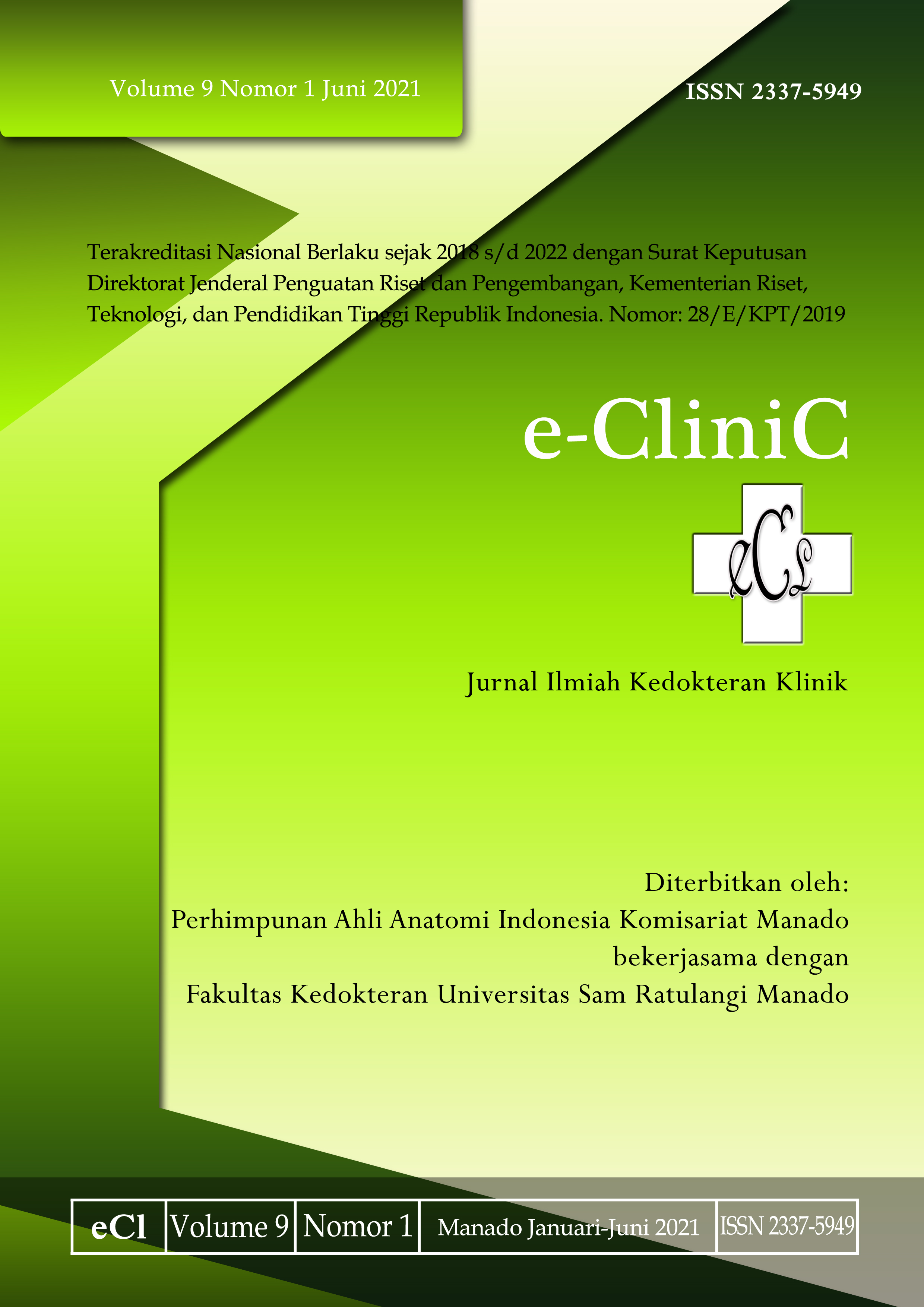Faktor Risiko yang Berhubungan dengan Kejadian Kelainan Bawaan pada Neonatus
DOI:
https://doi.org/10.35790/ecl.v9i1.32306Abstract
Abstract Congenital abnormalities are one of the main causes of infant mortality worldwide. Their symptoms vary from mild to severe. This study was aimed to determine the risk factors associated with the incidence of congenital abnormalities. This was a literature review study. The results obtained 10 articles that discussed about the risk factors of congenital abnormalities. The incidence of congenital abnormalities was more common in males. The most common factor was the maternal age of 20+ years Especially in Indonesia, there was no significant data about the risk factors related to the incidence of congenital abnormalities, however, two journals from Indonesia showed an increased incidence of congenital abnormalities in women infected during pregnancy. In addition, there were other risk factors found only in one to two journals, such as exposure to cigarettes, consumption of drugs or narcotics, and family history of previous congenital disorders. The review also covered several congenital disorders classified in organ systems dominated by the cardiovascular system. In conclusion, the risk factors associated with congenital abnormalities are maternal age, multiparity, history of abortion, congenital abnormalities in previous pregnancies, gestational diabetes, exposure to cigarette smoke, consumption of alcohol, consumption of drugs, not taking folic acid, family history of congenital abnormalities, consanguinity, and low socioeconomic status
Keywords: risk factor, birth defect, congenital anomalies, neonates
Â
                                   Â
Abstrak Kelainan kongenital merupakan salah satu penyebab utama kematian bayi di dunia dengan gejala bervariasi dari ringan hingga berat. Penelitian ini bertujuan untuk mengetahui faktor risiko yang berhubungan dengan kejadian kelainan kongenital. Jenis penelitian ialah literature review. Hasil penelitian mendapatkan 10 artikel mengenai faktor risiko kejadian kelainan kongenital. Kejadian kelainan kongenital lebih sering terjadi pada jenis kelamin laki-laki. Faktor risiko yang paling sering ialah usia ibu saat hamil mulai 20 tahun hingga lebih. Khusus di Indonesia belum ada data bermakna yang menunjukkan faktor risiko yang berhubungan dengan kejadian kelainan kongenital, namun dua artikel dari Indonesia menunjukkan peningkatan kejadian kelainan kongenital pada ibu yang terinfeksi saat hamil. Faktor risiko lainnya yang hanya didapatkan pada satu hingga dua jurnal saja seperti, paparan rokok, konsumsi obat maupun narkoba, serta riwayat keluarga yang pernah mengalami kejadian kelainan bawaan sebelumnya. Hasil kajian juga mendapatkan beberapa diagnosis penyakit kelaianan kongenital yang di golongkan dalam sistem organ, didominasi oleh sistem kardiovaskular. Simpulan penelitian ini ialah faktor risiko yang berhubungan dengan kelainan kongenital ialah usia ibu, multiparitas, riwayat abortus, kelainan ba kongenital waan pada kehamilan sebelumnya, diabetes gestasional, paparan asap rokok, konsumsi alkohol, konsumsi obat-obatan, tidak mengonsumsi asam folat, riwayat keluarga mengalami kelainan kongenital, adanya hubungan darah antara ayah dan ibu, dan status sosioekonomi rendah
Kata kunci: faktor resiko, kelainan kongenital, neonatusDownloads
How to Cite
Issue
Section
License
COPYRIGHT
Authors who publish with this journal agree to the following terms:
Authors hold their copyright and grant this journal the privilege of first publication, with the work simultaneously licensed under a Creative Commons Attribution License that permits others to impart the work with an acknowledgment of the work's origin and initial publication by this journal.
Authors can enter into separate or additional contractual arrangements for the non-exclusive distribution of the journal's published version of the work (for example, post it to an institutional repository or publish it in a book), with an acknowledgment of its underlying publication in this journal.
Authors are permitted and encouraged to post their work online (for example, in institutional repositories or on their website) as it can lead to productive exchanges, as well as earlier and greater citation of the published work (See The Effect of Open Access).







